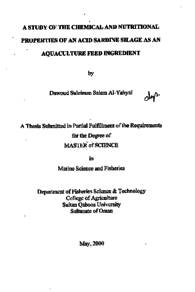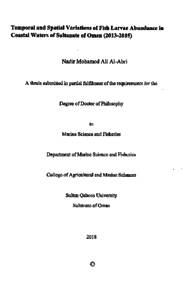Document
A study of the chemical and nutritional properties of an acid sardine ailage as an aquacul ture feed ingredient
Publisher
Sultan Qaboos University
Gregorian
2000
Language
English
English abstract
The costs of feeding fish represent between 30-60 % of the variable cost of intensive or semi-intensive fish culture. This is largely due to the high costs of fish meal needed to meet the protein requirements of some omnivorous and most carnivorous fish species. Considerable research is currently directed towards reducing the cost of feeds by replacing fish meal with alternative sources of protein. Fish silage is one possible alternative protein source for use in aquafeeds. Fish silage is a liquefied product which results from the process of hydrolysis when whole fish or processing wastes are ground and mixed with an acid or with a bacterial culture. The manufacture of fish silage is possible in regions where by-catch, surplus catches or fish processing wastes are available. In this study, sardines were chosen as the raw material for silage production since they are regionally-abundant, are harvested in quantities which exceed demand for consumption and consequently have low cost During this study the preparation of sardine silage was examined as a potential method for preparation of a stable, high protein feed ingredient. Dried sardine silage was evaluated through digestibility studies as a replacement for fish meal in practical diets for the tilapia, Oreochromis aureus.
A sardine silage was prepared by adding 1.5% v/v of a mixture of propionic and formic acids (1:1) to minced raw sardine An anti-oxidant ethoxyquin (200 ppm) was also added. The sardine silage was left outdoors at ambient temperatures during the liquefaction period and then sun-dried separately or after mixing with wheat bran. The resulting acid silage was stable, with pH in the range 4-4.5. After three days of ensiling, 60 % of the total nitrogen was measured as non-protein nitroger a rapid process of protein hydrolysis and breakdown to peptides and free amino acids. These changes were reflected in measurements of viscosity taken during liquefaction. Temperature during the ensiling period was 29-40 °C. Amino acid analysis of dried sardine silage revealed that the silage met the known qualitative and quantitative requirements of essential amino acids of fish. Fatty acid analysis and a high iodine value (271) confirmed the highly unsaturated nature of the fatty acids in sardine oil. From the results of fatty acid analysis, it was evident that dried sardine silage is a valuable source of essential and non-essential fatty acids for fish. The moisture content of co-dried sardine silage after 72 hr of drying was 10.6 %
compared to 16.0 % of the sardine silage. Mixing of the silage with a cereal, wheat bran, increased the rate of solar drying. The digestibility study showed that sardine silage was highly digestible for protein and gross energy with no significant differences measured between the digestibility of sardine silage and a high quality (72 % crude protein) commercial fish meal. Apparent digestibility coefficient (ADC % for protein and gross energy of sardine silage were 95.15 % and 89.85 % compared to those of fish meal, 95.82 % and 92.23 % respectively
This study demonstrated the potential for the production of a sun-dried sardine silage under ambient conditions of temperature and humidity in Oman. The dried silage had comparable chemical properties with a high-protein fish meal and was highly digestible by fish.
Member of
Resource URL
Arabic abstract
تمثل تكلفة التغنية حوالي 30-60% من تكلفة أي مشروع استزراع سمكي تحت نظام مكثف أو شبه مكثف، وهذا يعود الى ارتفاع قيمة العلف السمكي الذي يعتبر من أهم مصادر البروتين الحيواني في العليقة السمكية لمعظم الأسماك حيوانية التغذية و بعض الأسماك شائية التغذية. لذلك اتجهت البحوث في مجال الاستزراع السمكي الى محاولة تقليل تكلفة التغذية وذلك عن طرق إيجاد مصادر أخرى للبروتين الحيواني. ويعتبر سيلاج السمك واحدا من هذه المصادر التي يمكن الاعتماد عليها لتقليل تكلفة التغذية. وسيلاج السمك هو المنتج السمكي السائل الذي نحصل عليه بطحن الأسماك أو مخلفاتها وإضافة الأحماض أو وسط بكتيري اليها. ويمكن إنتاجه في المناطق التي يكثر فيها المصيد الجانبي، المصير الزائد عن الاستهلاك البشري، وكذلك عند توافر مخلفات تصنيع الأسماك. وقد أختير سمك السردين لإعداد السيلاج في هذه الدراسة لتوافره ويكميات كبيرة تزيد عن الاستهلاك البشري وكذلك لقلة اسعاره. وقد تم اختبار طريقة تحضير السردين في هذه الدراسة كطريقة ممكنة لإنتاج منتج غذائي عالي الجودة. وعن طريق تجارب الهضم، تم تقييم سيلاج السردين المجفف كبديل للعلف السمكي في غذاء أسماك البلطي (Oreochromis .(aureus وتم تحضير سيلاج السردين في هذه الدراسة بإضافة 1 . 5 % من خليط حمضي الفورميك والبروبيونك (1 : 1) إلى السردين المطحون. كما تمت إضافة مضاد الأكسدة اثيوكسكوين (200ج زء من المليون). وبعد عملية التحليل (تبدأ بإضافة الأحماض)، يتم تجفيف السيلاج تحت أشعة الشمس بمفرده او مخلوطا مع نخالة القمح. يكون السيلاج المنتج بهذه الطريقة ثابتا مع معدل حموضة يتراوح من 4-4 . 5. وبعد ثلاثة ايام من عملية التحليل، تكون نسبة النيتروجين غير البروتيني 60 % من النيتروجين، مما ي دل على سرعة عملية تحلل البروتين وكذلك تحوله الى ببتيدات واحماض امينية حرة. وقد ظهرت هذه التحولات في قياسات الكثافة السيلاج السردين خلال عملية التحليل. وتراوحت درجة الحرارة أثناء عملية التحليل م ن 29 - 40 درجة مئوية. وقد أظهرت هذه الدراسة مدى قدرة سيلاج السردين المجفف على مقابلة متطلبات اسماك البلطي من الأحماض الأمينية الأساسية. وقد أكدت تحاليل الأحماض الدهنية وقيمة اليود (271) الصفة الغير مشبعة العالية لزيت السردين. كما أكدت هذه التحاليل ان سيلاج السردين المجفف يعتبر مصدر غني للأحماض الدهنية الأساسية والغير أساسية للأسماك. وبعد 72 ساعة تجفيف، ك ان معدل الرطوبة للسيلاج في وجود نخالة القمح 10 . 64 % مقارنة بمعدل 16 . 06 % للسيلاج الخالي من نخالة القمح. وقد بينت دراسة التجفيف السيلاج السردين أيضا، أثر إضافة نخالة القمح كعامل مساعد لزيادة كفاءة التجفيف. كما أكدت تجارب الهضم، نسبة الهضم العالية البروتين والطاقة الكلية السيلاج السردين عند إضافته كمادة غذائية لسمك البلطي، وعدم وجود فروق تنكر بينه وبين العلف السمكي المستورد ع الي الجودة (72 % نسبة البروتين). فقد كان معدل هضم البروتين والطاقة الكلية لسيلاج السردين 95 . 15 % و 89
. 85 % مقارنة بمعدل هضم 95 . 82 % و 92 . 23 % على التوالي بالنسبة للعلف السمكي. تبين هذه الدراسة إمكانية إنتاج سيلاج السردين المجفف تحت أشعة الشمس في عمان في ظل الظروف المناخية من درجة حرارة ورطوبة، وخصوصا ان سيلاج السردين له خصائص كيميائية وغذائية قريبة جدا من العلف السمكي المستورد، كما أنه ذو خاصية هضم عالية عند إضافته كمادة غذائية للسمك.
. 85 % مقارنة بمعدل هضم 95 . 82 % و 92 . 23 % على التوالي بالنسبة للعلف السمكي. تبين هذه الدراسة إمكانية إنتاج سيلاج السردين المجفف تحت أشعة الشمس في عمان في ظل الظروف المناخية من درجة حرارة ورطوبة، وخصوصا ان سيلاج السردين له خصائص كيميائية وغذائية قريبة جدا من العلف السمكي المستورد، كما أنه ذو خاصية هضم عالية عند إضافته كمادة غذائية للسمك.
Category
Theses and Dissertations


